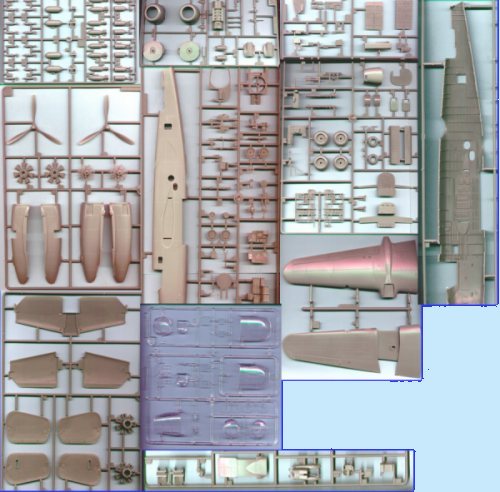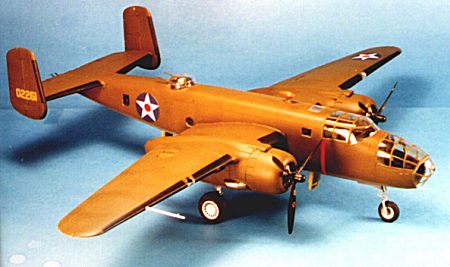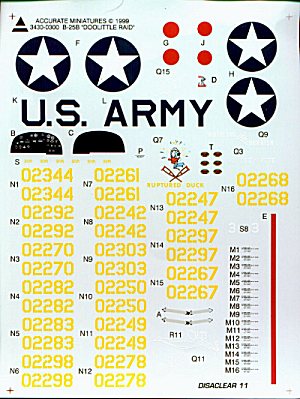
|
KIT: |
Accurate Miniatures 1/48 B-25B |
|
KIT # |
34.30 |
|
PRICE: |
$49.98 |
|
DECALS: |
All 16 Doolittle Raiders |
|
REVIEW & |
|
|
NOTES: |
|

|
HISTORY |
 Named for General Billy
Mitchell, American proponent of strategic air power, the North America B-25
"Mitchell" was the best all-round light-medium bomber of the Second
World War. The airplane was docile and adaptable, with all-round excellent
performance and particularly good handling characteristics. It was one of the
most popular aircraft among Allied aircrews. It was manufactured in greater
numbers than any other American twin-engine bomber, no less than 9,816 B-25s
being accepted during the war, and it served a number of Allied air forces.
Named for General Billy
Mitchell, American proponent of strategic air power, the North America B-25
"Mitchell" was the best all-round light-medium bomber of the Second
World War. The airplane was docile and adaptable, with all-round excellent
performance and particularly good handling characteristics. It was one of the
most popular aircraft among Allied aircrews. It was manufactured in greater
numbers than any other American twin-engine bomber, no less than 9,816 B-25s
being accepted during the war, and it served a number of Allied air forces.
(I can personally attest to the outstanding handling and maneuverability of the B-25, because out at Chino we throw "Photo Fanny" around the sky like a P-38 on our air-to-air photo missions and the airplane never complains, though I did when I nearly fell out once!)
Had the B-25 only ever flown one mission against one target, it would be ranked among the truly historic aircraft of the war for the attack against Japan flown by 16 B-25Bs led by LCOL Jimmy Doolittle off the carrier "Hornet" on April 14, 1942. The scheme required an airplane with an overall range of 2,400 miles carrying a one-ton bomb load. The volunteer crews came from the 17th Bombardment Group, the first USAAF unit to fly the Mitchell. The raiders successfully bombed targets in Kobe, Yokohama, and Nagoya, as well as Tokyo. Though all sixteen aircraft were subsequently lost, and the military damage inflicted was negligible, the raid accomplished to major items: it gave the United States and her allies in the Pacific War a "shot in the arm" at a very bleak period of the war; more importantly, it led the Imperial Japanese Navy to plan the invasion of Midway, which would lead to the decisive battle of the war, one which doomed Japan to eventual defeat.
|
THE KIT |
 Modelers have been
waiting now for close to two years since Accurate Miniatures announced their
series of early B-25s. Opening the box clearly demonstrates that all other 1/48
scale B-25s that have been produced prior to this kit are now effectively
obsolete. The big box is full of 8 sprues of crisply-molded dark grey plastic,
of the quality we have come to expect from the company that produced the TBF
Avenger, SBD Dauntless, Il-2 Shturmovik and F3F. Separately packaged is a very
clear sprue of cockpit glass; there is some distortion here due to the shapes
that had to be molded, and it looks like dipping these parts in Future will be
necessary to allow viewers to see the interior in all its glory.
Modelers have been
waiting now for close to two years since Accurate Miniatures announced their
series of early B-25s. Opening the box clearly demonstrates that all other 1/48
scale B-25s that have been produced prior to this kit are now effectively
obsolete. The big box is full of 8 sprues of crisply-molded dark grey plastic,
of the quality we have come to expect from the company that produced the TBF
Avenger, SBD Dauntless, Il-2 Shturmovik and F3F. Separately packaged is a very
clear sprue of cockpit glass; there is some distortion here due to the shapes
that had to be molded, and it looks like dipping these parts in Future will be
necessary to allow viewers to see the interior in all its glory.
And the interior is indeed glorious. Everything is there.
A very nice touch is the inclusion of brass weights which come in pieces, so that they can be slid into the various nooks and crannies necessary to make the glass-nose B-25 sit on its nose wheel without filling up that beautiful interior with fishing weights.
The decals include all the serial numbers to do each of the 16 aircraft used in the Tokyo raid. The boxart airplane is Ted Lawson's "Ruptured Duck," one of three airplanes to be named, and the one which was immortalized in his book "Thirty Seconds Over Tokyo" and the classic movie of the same name written by Dalton Trumbo and starring Spencer Tracy and Van Johnson. It's a lead-pipe cinch that this will be the airplane most modelers will make; I know it is a fact your reviewer will be doing so.
|
CONSTRUCTION |
 Accurate Miniatures has
detailed step-by-step construction of this kit at their website, and I strongly
recommend that you go to Accurate
Miniatures' Website for that kind of detailed description.
Accurate Miniatures has
detailed step-by-step construction of this kit at their website, and I strongly
recommend that you go to Accurate
Miniatures' Website for that kind of detailed description.
Overall, the kit is an assembler. Anyone who can read and follow the very clear instructions will have virtually no problems with the construction of this model. Note, however, that I said "virtually no problems." In fact, this kit presents problems with regard to fit that I have not experienced with any other Accurate Miniatures kit. However, were this a kit from any other manufacturer besides Tamiya, I would not register any surprise at the fit. This is an indication of just how high Accurate Miniatures has set their own bar.
I found that if I attached the lower section of the bombardier nose to the fuselage before attaching the bombardier canopy, that I was better able to deal with the fit problem of this part that other reviewers have mentioned. Once this was set, attaching the glass was no problem, other than to run a line of white glue along the fusealge/glass joint, to cover a narrow gap. With clear parts, I prefer white glue as a gap-filler to cyanoacrylates, even if the parts have been given the protection of Future. I still needed some putty on the lower part of the nose to get a smooth joint before attaching the glass.
I also found that the nacelles did not join the wings smoothly at the trailing edge joint. I needed putty to smooth that up.
I also found a gap when the cockpit canopy was installed, along the rear join line. This was also filled with white glue and looked fine once it was painted over.
Personally, I doubt I will waste my time in the future on other B-25 models by assembling all the interior detail in the rear of the fuselage. None of this is visible once the fuselage halves are glued together.
Other than these problems, construction of the model is straightforward.
|
PAINT & DECALS |
 The Doolittle Raiders
were repainted at McClellan Air Force Base just prior to being flown to Alameda
and loaded aboard the "Hornet." Thus, the paint is not faded, and
there are no exhaust stains to speak of. I did pre-shade the model by
airbrushing flat black along all panel lines, which gave a certain depth to the
final finish; something like this is particularly necessary on a model this
large that has such a monochromatic finish. I used Tamiya "Neutral
Grey" and Gunze Sanyo "Olive Drab."
The Doolittle Raiders
were repainted at McClellan Air Force Base just prior to being flown to Alameda
and loaded aboard the "Hornet." Thus, the paint is not faded, and
there are no exhaust stains to speak of. I did pre-shade the model by
airbrushing flat black along all panel lines, which gave a certain depth to the
final finish; something like this is particularly necessary on a model this
large that has such a monochromatic finish. I used Tamiya "Neutral
Grey" and Gunze Sanyo "Olive Drab."
If you do not go to the Accurate Miniatures website, allow me to warn you that the vinyl masks for the fuselage windows are oversize, having been measured from the inside dimensions. I applied these, then trimmed them with a brand-new No. 11 blade and had no other problems. The masks fit the bombardier's canopy and the cockpit canopy perfectly, and are a welcome change from having to apply and trim Scotch tape, which would have been the alternative otherwise. I have been told by Bill Bosworth that this problem will be solved on future releases.
 As a big fan of both the
book and the movie, "Thirty Seconds Over Tokyo," it was a foregone
conclusion that I would do author Ted Lawson's "Ruptured Duck." The
decals are all in register and went on well, snuggling down under a couple of
"paintings" of Micro-Sol.
As a big fan of both the
book and the movie, "Thirty Seconds Over Tokyo," it was a foregone
conclusion that I would do author Ted Lawson's "Ruptured Duck." The
decals are all in register and went on well, snuggling down under a couple of
"paintings" of Micro-Sol.
I then gave the airplane two coats of "Flat Future" and when it was dry removed the masks and attached the landing gear and wheels. I also inserted the gun turret at this time. A note about the turret: the Martin turret does not have any braces on it, and should be left entirely unpainted. Before installing the turret in the model, you should fill in the gun slots with white glue. When it dries it will be taught, and can then be painted Olive Drab; it will look very close to the canvas with zippers that was used to seal these turrets on the real airplane.
|
CONCLUSIONS |
If the F3F-1 kit is an A+, this kit is an A, the difference being the minor fit problems experienced. As you can see from the photos, the kit builds into an impressive model. This particular model will be part of the Doolittle Raiders display at The Air Museum, Planes of Fame, in Chino, California, with the display open to the public in April, the 58th anniversary of the Tokyo Raid.
I am really looking forward to the B-25C/D, which I expect will look even better now that I know what to watch out for.
If you would like your product reviewed fairly and quickly by a site that has over 800 visits a day, please contact the editor or see other details in the Note to Contributors.